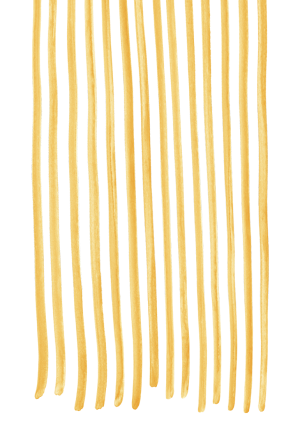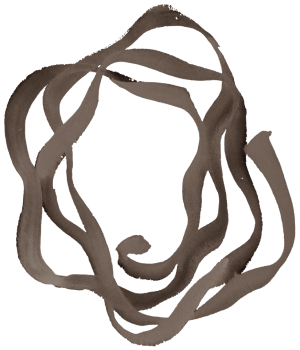SUMMER
Our Pasta Programme
Every season, we shine the spotlight on a series of traditional pasta shapes fabricated using age-old techniques. Delve into their culinary anthropology, from the historical events that gave birth to them to the regional touches that have shaped them over time.
This Summer, dive into our fresh array of pasta shapes and vibrant plates, perfect for sunny days and warm nights of the season. Rejoice in the return of two simple yet beloved dishes from Campania—Linguine al Limone, where the Amalfi lemons of Sorrento shine in a sauce as light as it is bright; and Spaghetti alla Nerano, one of the most iconic pasta and zucchini pairings from the village of Nerano.
Delve into Salento’s longstanding love affair with fresh pasta in Minchiareddi al Nero di Seppia con Sugo di Granchio, a dish that marries the deep, briny notes of squid ink with the sweet, delicate flavour of Alaskan king crab. Dip your feet into the sun-drenched, azure shores of Liguria, where Trenette allo Scoglio brings together the Mediterranean’s freshest bounty in a velvety lobster butter sauce.
Embark on a journey through Italy’s nuanced regional diversity, season by season, one pasta strand, parcel, or shape at a time.
Our Pasta Programme
Every season, we shine the spotlight on a series of traditional pasta shapes fabricated using age-old techniques. Delve into their culinary anthropology, from the historical events that gave birth to them to the regional touches that have shaped them over time.
This Summer, dive into our fresh array of pasta shapes and vibrant plates, perfect for sunny days and warm nights of the season. Rejoice in the return of two simple yet beloved dishes from Campania—Linguine al Limone, where the Amalfi lemons of Sorrento shine in a sauce as light as it is bright; and Spaghetti alla Nerano, one of the most iconic pasta and zucchini pairings from the village of Nerano.
Delve into Salento’s longstanding love affair with fresh pasta in Minchiareddi al Nero di Seppia con Sugo di Granchio, a dish that marries the deep, briny notes of squid ink with the sweet, delicate flavour of Alaskan king crab. Dip your feet into the sun-drenched, azure shores of Liguria, where Trenette allo Scoglio brings together the Mediterranean’s freshest bounty in a velvety lobster butter sauce.
Embark on a journey through Italy’s nuanced regional diversity, season by season, one pasta strand, parcel, or shape at a time.


Calamarata con Pesce Spada alla Ghiotta
Origins: Messina, Sicily (Islands)
Bronze-extruded short wide tubes with poached swordfish, Sicilian pistachios, oregano and capers
There are plenty of pasta in Sicily that feature a combination of nuts—pistachios, pine nuts or almonds—and seafood. Swordfish, or pesce spada, in particular, is a majestic, indigenous species of fish that play an important role in the cuisines of Sicily and Calabria, where they have been historically fished. Highly prized for its meaty texture and delicate flavour, it is as quick as it is easy to prepare. Every Spring, the Straits of Messina, which carves out the borders between Sicily and Calabria, carries an abundance of swordfish passing through in pairs. Fishermen from both regions will set out to sea in uniquely constructed vessels known as passarelle, strategically going after the female swordfish knowing that her male counterpart will valiantly defend her honour, whereas a captured male will only see the slippery female fading away into the current. Alla ghiotta, which translates to “glutton’s style”, comes in a heaping plate of admittedly good things from Sicily: tomatoes, capers, olives, onions, Pistacchio verde di bronte D.O.P., fresh herbs, and savoury anchovies. The use of swordfish sets this dish apart as a thorough-bred Sicilian gastronomic tradition.

Linguine al Limone
Origin: Salerno, Campania (South)
Bronze-extruded linguine with a light and bright sauce made using Amalfi lemons and Provolone del Monaco D.O.P.
This is a dish that has ambiguous roots in the deep south—or Mezzogiorno—notably in the area of the Amalfi coast and the Sorrento peninsula charaterised by its staggering cliffs, meandering coastal roads and famous beaches. The cuisine is also underlined by fresh and zesty flavours, with the lemons of Sorrento prized for its aroma and sweetness coming off the top of the list of regional produce. With its large size, thick, uneven rinds and a sugar content that verges on a slight sweetness, it is precisely these qualities that are crucial in producing the world famous Limoncello with Sorrento as the Limoncello capital of Italy. Despite its strong ties to the south, the technicality of this underrated dish bears stark resemblance to one of Rome’s most famous pasta dishes with the emulsification of cheese and water as the backbone of its execution style, but with a brighter note from the lemon’s zest and its juice. We use a long, bronze-extruded linguine that is well suited for holding light, delicate sauces. Its porous and increased surface area is the perfect utility for the emulsified sauce made using Amalfi lemons and Provolone del Monaco DOP.



Ciccioneddos al Sugo d’Agnello
Origins: Sassari, Sardinia (Islands)
Short pasta made with semola and water, rolled over a pettine, and paired with a hearty lamb sugo and smoky shavings of Fiore Sardo D.O.P.
The island of Sardinia may be surrounded by crystal-clear waters and fresh bounty of the Mediterranean Sea, but it offers just as many delicacies from the land. Products like pecorino and the celebrated Sardinian roast suckling pig, porceddu, are the result of long-standing pastoral traditions. Among these delicacies is gnochetti sardi, a historic pasta shape that has been a staple in the kitchens and restaurants of Sardinia for centuries. While similar pasta shapes exist throughout Italy, the gnochetti from Sardinia have a unique heritage characterised by the simple ingredients of durum wheat, water, and salt. A smaller variation, known as Ciccioneddos, originates from the town of Ittiri in Sassari. These little pasta pieces are known for their sauce-trapping grooves and are traditionally rolled out for weddings and celebrations. We pay homage to the Sardinian hinterland with a hearty lamb sugo and Fiore Sardo D.O.P, a smoky pecorino imbued with flavours distinct to the island.

Spaghetti alla Nerano
Origins: Naples, Campania (South)
Bronze extruded long pasta with zucchini, basil and Provolone del Monaco D.O.P.
Pasta and zucchini pairings are a dime a dozen across Italy, but only one can lay claim to Stanley Tucci dubbing it as one of the best things he’d ever eaten. Like many other dishes, this pasta dish carries the namesake of the village where it originated. Invented in the village of Nerano in the 1950s on the Sorrento peninsula, specific ingredients were used to set it apart from the rest. In the kitchen of one Maria Grazia, Provolone del Monaco DOP, a very regional semi-aged cheese made from the milk of the Agerolese cow, along with the clever use of basil were added to elevate an otherwise ordinary number with layers of sweet and slightly spicy notes. Today, it is prepared daily, both in the homes across Naples and in Campania restaurants with slight variations from the famed version. We use Spaghetti, a long, thin cylindrical pasta that needs no introduction but deserves a special mention. Given its tendency for starch to be better released to aid in the ‘mantecatura’ of the components—cohesively binding condiment and noodles—matched with the rugged profile of its bronze-drawn nature, the cling factor to an incredible sauce is doubled.



Struncatura Ammollicata
Origins: Reggio Calabria, Calabria (South)
Bronze-extruded long rye pasta with anchovies, taggiasca olives, chilli and breadcrumbs
Struncatura is a long bronze-extruded pasta that resembles a thick trenette that was once the ancient cucina povera speciality of Reggio Calabria. Translated from the Calabrese dialect, struncatura means “scraps” or “crumblings” or “sawdust” and, in this case, refers to the floor sweepings of wheat milling operations in the past, where by-products of the process would carpet the mill flour which would either be swept from the floor, destined to be animal feed, or used to produce a very cheap, dark coloured pasta product, peddled to only the most destitute. Often known as a ‘poor man’s dish’ because it was prepared with low-cost ingredients, it has since emerged from notoriety and earned its cult status in Lucanian gastronomy. We stay true to its humble origins with Mediterranean flavours of anchovies, taggiasca olives, chilli and Mollica di Pane—sauteed breadcrumbs that were considered ‘cheese of the poor’.

Minchiareddi al Nero di Seppia con Sugo di Granchio
Origins: Salento, Puglia (South)
Short squid ink pasta made with semola and water pressed over a wire, or “lu fierru”, paired with a light tomato sugo made from Alaskan king crabs
Available in limited quantities as a special only
Minchiareddi al Nero di Seppia con Sugo di Granchio is a captivating pasta dish that celebrates the rich culinary heritage of Salento. This dish features minchiareddhi, a traditional short pasta crafted from semola and water, dyed black with squid ink and shaped by pressing the dough over a wire known as “lu fierru”. The pasta is paired with a light tomato sugo made from succulent Alaskan king crab, bringing a touch of luxury to the rustic flavors. The minchiareddi, also known as maccarruni, is a staple in Salento cuisine, traditionally prepared by housewives through an intensive manual process dating back to the eighteenth century. This fresh pasta—along with many others that hail from Salento—once a symbol of accessibility to high-quality food for farmers and fishermen, remains a cherished tradition in Salento households. Today, minchiareddi is still celebrated for its tapered and elongated shape, often seasoned with simple fresh tomato sauce or, as in this dish, with fish-based sauces. The pairing with a crab-infused tomato sauce adds a modern twist to this historical dish, marrying the deep, briny notes of squid ink with the sweet, delicate flavour of the crab.



Trenette allo Scoglio
Origins: Genoa, Liguria (North-West)
Bronze-extruded long pasta with a medley of seafood including tiger prawns, mussels, manila clams, scallops, and grilled calamari, cooked in a lobster butter sauce.
Available in limited quantities as a special only
Trenette allo Scoglio, a celebrated dish from the enchanting coastal region of Liguria, Italy, captures the very essence of the Mediterranean’s bountiful waters. Trenette is a long, flat pasta similar to linguine, traditionally made from semolina and water. The name “allo Scoglio”, meaning “on the rocks,” evokes the rugged beauty of the rocky Ligurian coastline, where fresh seafood is abundant. This pasta features a luxurious medley of seafood such as clams, mussels, shrimp, and squid, all sautéed with fragrant garlic, vibrant cherry tomatoes, and a splash of white wine to create a savoury sauce. At Forma, we double down on indulgence by coating the entire dish in a velvety lobster butter sauce. The history of Trenette allo Scoglio is deeply intertwined with the maritime culture of Liguria, where fishing has been a way of life for centuries. Ligurian fishermen would often prepare this dish using their daily catch, embodying the region’s tradition of simplicity, freshness, and robust flavors. Over time, Trenette allo Scoglio has become a staple of Ligurian cuisine, celebrated for its authentic taste of the sea and its reflection of the region’s rich culinary heritage.


